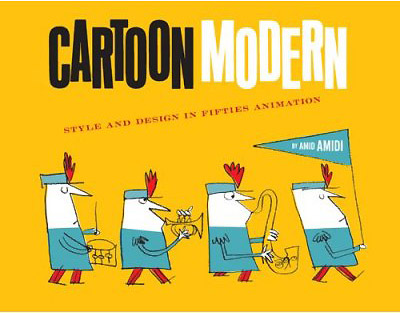
Cartoon Modern: Style and Design in Fifties Animation
Author: Amid Amidi
Artist: Adam Stower
Publisher: Chronicle Books
ISBN 10: 0-8118-4731-4
ISBN 13: 978-0-8118-4731-5
Up to about 1950, there was only one art style in theatrical animated cartoons; the pictorial realism established by Walt Disney. Then, beginning in the late ’40s, new studios emerged with radically different cartoon styles that could never be mistaken for Disney’s.
This beautifully designed 200-page book examines in detail, with color illustrations on almost every page, the explosion of “modern art”styles in cartoons of the 1950s. Amidi traces it back to the early 1940s, when a non-Disney style began to appear in industrial films produced by small, new studios. The ’50s not only brought new studios like UPA (the Mr. Magoo cartoons, among others) to theater-goers’ attention, but the new medium of television brought cartoons into every home with animated TV commercials for adults, not to mention TV cartoons produced for children. In addition, established theatrical animation studios like Warner Bros., Terrytoons, and Disney itself began to embrace stylized modernism in their works.
Amidi studies the American cartoon animation of the 1950s on a studio-by-studio basis. Some studios, especially those that concentrated on TV commercials, are virtually unknown by name today, but their work was highly influential at the time and is still remembered by nostalgic fans of “classic TV”: the Hamms Beer Bear, Bucky Beaver promoting Ipana toothpaste, and the like. Warner Bros. and Disney are shown to have adopted modernism to an extent often forgotten today, such as WB’s heavy use of abstractly stylized backgrounds by Maurice Noble and Disney’s surrealistic Tomorrowland TV features like “Mars and Beyond” by Ward Kimball. The cartoons of UPA (United Productions of America) represented the pinnacle of “anti-Disney” modernistic art, and Cartoon Modern devotes many pages to its most daring and critically-acclaimed cartoons such as “Rooty-Toot-Toot” and “The Tell-Tale Heart”.
Academy Pictures. Grantray-Lawrence Animation. John Sutherland Productions. Playhouse Pictures. Shamus Culhane Productions. These and other studios are profiled, along with the directors and art designers that created their works. The graphics include animation model sheets, design sketches, cels, background paintings, candid photos, posed group photos, and more, many never published before. Cartoon Modern is an essential book for anyone who wants to know about American animation in the 1950s, when it was transitioning away from dominance by the theatrical market to television, and the classic “Disney look” was being added to by dozens of more modernistic art styles.






I’m reading this book now. Amidi does a great job in exploring the studios he does cover. However, there are two obvious omissions–Jay Ward Productions and Paramount/Famous Studios. Both studios were also influenced by UPA during the mid to late fifites.